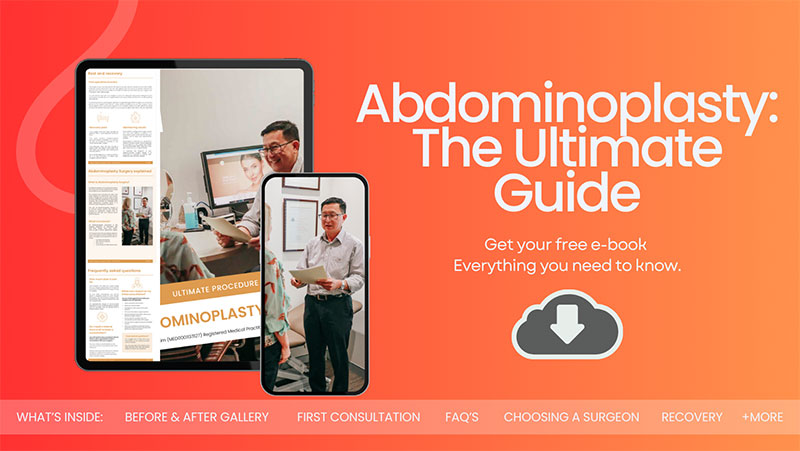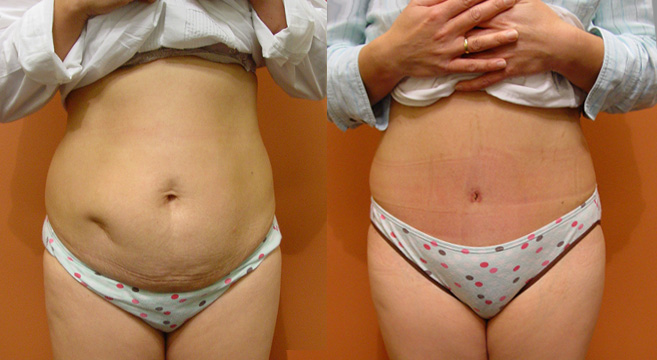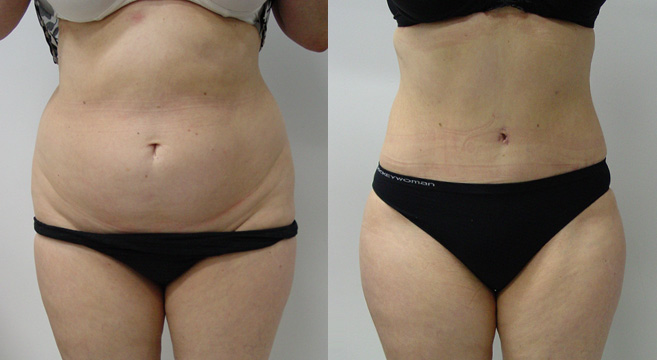Guide to Diet and Exercise after Tummy Tuck – Abdominoplasty
Abdominoplasty is a surgical procedure aimed at reshaping and firming the abdominal area. The initial results become more visible as post-operative swelling decreases. However, to maintain these results over the long term, it is important to adopt specific lifestyle changes, particularly in the areas of diet and exercise. A balanced diet and regular physical activity play a significant role in preserving the outcomes of abdominoplasty, helping to prevent weight gain and ensure the longevity of the surgical results.
In this blog, Sydney Specialist Plastic Surgeon Dr Jake Lim will discuss the details of diet and exercise after tummy tuck – abdominoplasty to maintain the results of the procedure.
Download Dr Lim’s Free 2024 Abdominoplasty Guide

What Is Abdominoplasty?
This surgical procedure is suitable for individuals who have excess skin and fat in the abdominal area. It’s also a procedure among women post-pregnancy, as well as men and women who have undergone significant weight loss and are left with loose skin.
However, a common misconception surrounding abdominoplasty is its perceived role as a straightforward weight-loss solution. It’s important to understand that abdominoplasty is not a substitute for weight loss but rather a contouring procedure designed to tighten and remove excess skin and fat that has not responded to traditional weight loss methods. Good candidates for this surgery are those who are already at or near their ideal body weight but are looking to refine and reshape the contour of their abdomen.
The procedure itself involves the removal of excess skin and fat from the middle and lower abdomen and the tightening of the abdominal wall muscles. This not only alters the physical appearance but also can improve posture and alleviate some forms of back pain associated with weak abdominal muscles. Despite its benefits, abdominoplasty is a major surgery that requires a significant recovery period, underscoring the importance of a patient’s commitment to maintaining their results through a healthy lifestyle post-surgery.

Diet and Exercise Immediately after Tummy Tuck – Abdominoplasty
The journey to recovery and beyond begins immediately after the abdominoplasty procedure. The initial post-operative phase is important for healing and sets the foundation for the long-term maintenance of the surgery’s results. During this period, you are advised to take it easy, avoiding any strenuous activities that could jeopardise the healing process. However, light walking is often encouraged to promote blood circulation and prevent the formation of blood clots.
Nutrition plays also a role in the recovery phase. A balanced diet rich in vitamins, minerals, and proteins is essential for repairing tissues and reducing the risk of complications. You will be encouraged to consume foods high in vitamin C and zinc to boost the immune system and promote wound healing, while protein-rich foods aid in the repair of muscle and skin tissues. Hydration is equally important, as it facilitates the body’s natural healing processes and helps reduce swelling.
Adhering to dietary recommendations post-surgery can be challenging, especially when dealing with the physical and emotional stress of recovery. However, the effort is well worth it, as a nutritious diet can significantly impact the speed and quality of healing. You will be advised to plan your meals in advance, ensuring you have easy access to healthy, nutrient-dense foods that support the recovery.
As the body begins to heal, and with Dr Lim’s approval, you can gradually reintroduce more substantial forms of exercise beyond light walking. It’s important to follow Dr Lim’s guidance on when and how to safely incorporate different types of physical activity. This cautious approach ensures that the results of the abdominoplasty are not compromised during the recovery phase.
The immediate post-op phase is a time for you to listen to your bodies and give yourself the care and attention needed to heal.
Long-Term Diet Strategies to Maintain Abdominoplasty Results
After navigating the initial recovery phase post-abdominoplasty, the focus shifts towards long-term lifestyle adjustments to maintain the surgical results. A balanced diet plays a role in this journey, acting as the foundation of sustained weight management and overall health. The goal is not just to maintain the aesthetic results of the surgery but also to foster a healthier relationship with food that supports physical well-being.
A balanced diet keeps the body nourished, energised, and capable of warding off diseases. For abdominoplasty patients, it’s particularly important as it helps maintain the results by preventing weight gain that can stretch the skin and negate the tightening effects of the surgery. A diet rich in fruits, vegetables, lean proteins, whole grains, and healthy fats provides the body with the necessary nutrients to repair tissue, maintain muscle mass, and support a healthy metabolism.
Dietary Recommendations
- Protein-Rich Foods: Protein is vital for muscle repair and maintenance. Incorporating lean meats, fish, eggs, dairy, and plant-based proteins like beans and lentils can help preserve muscle mass and promote skin elasticity.
- Fruits and Vegetables: High in vitamins, minerals, and fibre, fruits and vegetables should make up a significant portion of the diet. They help with digestion, reduce inflammation, and support skin health.
- Whole Grains: Foods like brown rice, quinoa, and whole wheat bread are excellent sources of fibre and nutrients. They help keep you full longer, aiding in weight management.
- Healthy Fats: Avocados, nuts, seeds, and olive oil provide healthy fats that are essential for nutrient absorption and maintaining healthy skin.
- Hydration: Drinking plenty of water is essential for flushing toxins from the body, maintaining skin hydration, and supporting overall health.
Avoiding Common Dietary Pitfalls
Maintaining a healthy diet requires mindfulness to avoid common pitfalls such as emotional eating, high-sugar foods, and processed snacks. These can lead to weight gain and adversely affect the results of the abdominoplasty. Planning meals, keeping healthy snacks on hand, and being mindful of portion sizes can help manage these risks.

Exercise after Abdominoplasty
Exercise is equally important as diet in maintaining the results of abdominoplasty. It not only helps in weight management but also strengthens the core muscles, improving the overall contour and appearance of the abdomen.
The timeline for reintroducing exercise post-abdominoplasty varies for each individual, depending on their unique recovery process. Generally, light walking is encouraged immediately after surgery to promote circulation. More strenuous activities, including weight training and aerobic exercises, should only be reintroduced after receiving clearance from Dr Jake Lim, typically around 6 to 8 weeks post-surgery.
Recommended Exercises
- Core Strengthening: Once cleared by Dr Lim, core exercises such as planks, pelvic tilts, and gentle yoga can help strengthen the abdominal muscles without straining the surgery site.
- Cardiovascular Activities: Walking, cycling, and swimming are excellent low-impact cardio exercises that can help maintain weight and improve overall fitness without putting too much stress on the abdomen.
- Strength Training: Incorporating full-body strength training helps maintain muscle mass, supports metabolism, and contributes to a toned appearance. Focus on gradual progression and proper form to avoid injury.
Tips for Exercise after Abdominoplasty
Exercising after abdominoplasty can help maintain the results of your surgery and ensuring a healthy recovery. However, it’s important to approach your post-surgery fitness routine with care and proper guidance. Here are some tips to help you safely reintegrate exercise after your abdominoplasty:
1. Start Slow
- Begin with light activities such as walking to promote blood circulation and reduce the risk of blood clots. Gradually increase the intensity and duration of your workouts as you feel more comfortable and with Dr Lim’s approval.
2. Listen to Your Body
- Pay close attention to how your body responds to exercise. If you experience pain (beyond mild discomfort) or any signs of strain on your surgical site, stop immediately and consult your medical team.
3. Focus on Core Strength
- Once you’re cleared for more strenuous activities, incorporate exercises that strengthen your core muscles. Start with gentle exercises and avoid any that put too much pressure on your abdomen initially.
4. Avoid Heavy Lifting and High-Impact Activities
- In the early stages of your recovery, avoid heavy lifting and high-impact activities that could jeopardise your healing process. Gradually reintroduce these activities as recommended by your healthcare provider.
5. Wear Appropriate Support
- Depending on Dr Jake Lim’s recommendations, you may be advised to wear a compression garment during certain activities to support your abdomen as it heals.
6. Be Patient with Your Progress
- Understand that regaining your pre-surgery fitness level will take time. Be patient with your body and allow it the time it needs to fully recover.
It’s essential to develop an exercise plan tailored to your individual needs and recovery status. Consulting with a fitness professional who understands the specifics of abdominoplasty recovery can be invaluable. They can design a program that safely progresses in intensity, ensuring that you strengthen your body without compromising your surgical results.
FAQs about Diet and Exercise to Maintain Abdominoplasty Results

What are the best foods to eat during my recovery from abdominoplasty?
- During your recovery, focus on eating a balanced diet rich in vitamins, minerals, and proteins to aid in healing. Include plenty of fruits and vegetables, lean proteins (such as chicken, fish, tofu, and legumes), whole grains, and healthy fats (like avocados, nuts, and olive oil). Staying hydrated is also crucial, so drink plenty of water.
Will I need to change my diet long-term after abdominoplasty?
- Yes, maintaining the results of your abdominoplasty involves adopting a healthy, balanced diet long-term. This doesn’t mean you have to follow a strict diet but rather make mindful choices that include a variety of nutrients to support your overall health and prevent significant weight fluctuations that could affect your results.
Are there any exercises I should avoid after abdominoplasty?
- Initially, you should avoid any exercises that strain the abdominal area, such as heavy lifting, intense core workouts, and high-impact cardio. Gradually reintroduce these activities as your body heals and with your plastic surgeon’s approval. Listening to your body and avoiding exercises that cause discomfort or pain in the surgical area is crucial.
Can I undergo abdominoplasty if I plan to lose more weight?
- It’s generally recommended to be at or near your ideal weight before undergoing abdominoplasty. Significant weight loss after the procedure can affect the appearance of your results, potentially leading to additional loose skin. If you plan to lose more weight, discuss your goals with Dr Jake Lim to determine the best timing for your surgery.
What happens if I gain weight after abdominoplasty?
- Gaining a small amount of weight after abdominoplasty is unlikely to significantly impact your results. However, substantial weight gain can stretch the skin and abdominal area, potentially reversing some of the benefits of the surgery. Maintaining a stable weight through a balanced diet and regular exercise is key to preserving your results.
Further Reading about Abdominoplasty with Sydney Specialist Plastic Surgeon Dr Jake Lim
- Read Dr Jake Lim’s Blog about Abdominoplasty for Men: Breaking Down the Myths
- Read Dr Jake Lim’s Blog about Will I Still Have Abdominal Rolls or Folds After Abdominoplasty Surgery?
- Read Dr Jake Lim’s Blog about How Your BMI Impacts Abdominoplasty Results
- Read Dr Jake Lim’s Blog about Medicare Cover for Abdominoplasty Surgery in Sydney
- Read Dr Jake Lim’s Blog about Recovery after Tummy Tuck – Abdominoplasty
Medical References about Diet and Exercise after Abdominoplasty
- The Impact of Protein Nutritional Supplementation for Massive Weight Loss Patients Undergoing Abdominoplasty
- What to Know About Recovery from a Tummy Tuck – WebMD
- Tummy tuck – Mayo Clinic
- Tummy tuck (abdominoplasty) – NHS
- Tummy Tuck (Abdominoplasty): Surgery, Recovery, Risks – Cleveland Clinic
About Dr Jake Lim
Highly qualified and experienced specialist plastic surgeon Dr Jake Lim focuses on facial plastic, cosmetic breast and body contouring after significant weight loss
Dr Lim creates the best possible plastic surgery results for his Australia-wide and international patients.
Dr Lim is passionate about making sure each and every patient has access to the right information about available treatments and procedures and is able to make well-informed decisions.
At My Klinik, patient safety, education and achieving optimal results are our top priorities.




